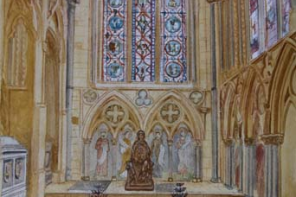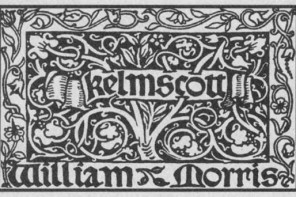I’ve been particularly intrigued by the conversation that has come from Jim’s post on Monday about SPJP, especially Jim’s question in the comments about whether ‘watching and contemplation can be recovered as an act of worship’. There has been a (in my opinion) much-needed move to save art from the modernist ideas that art is intended only for aesthetic contemplation and to rediscover it as an object of action (perhaps seen most explicitly in Nicolas Wolterstorff’s Art in Action). There seems to be agreement that art exists within a multiplicity of purposes and functions – some active, some contemplative, some communal, some individual. We continue to wrestle with the appropriate ‘use’ of the arts on this blog and I want to add to the discussion and pick up on Jim’s question – can (and should) contemplation be recovered in worship?
Daniel Siedell engages with this issue in his book, God in the Gallery. Siedell argues that the Christian suspicion of modern art’s emphasis on contemplation has been misunderstood due to a lack of engagement with its philosophical and theological conditions. (22) However, Siedell does not believe that this suspicion arose at the advent of modern art but can find its roots at the Reformation, when words were elevated over images. While Luther did not reject images outright, he ‘did not allow religious images to stand alone, as visual, aesthetic artifacts for contemplation and veneration’. (135) This move away from contemplation and veneration resulted in a fundamental shift in the role of art in the church. It went ‘from a primary means of spiritual contemplation and communion to a supportive function as a tool of education and communication.’ (137) It seems that from Siedell’s perspective, art for contemplation (and probably not just the individual kind) has existed in the church before. This topic is big and rather than try and draw conclusions, I’d like to ask a few questions to get discussion going:
What do you think about Siedell’s claim – is our ‘suspicion’ of contemplation linked to the Reformation? Has a distrust of images and an elevation of words led to an overemphasis on ‘action’ in worship, leaving behind contemplation as a worshipful activity? Can contemplation of art be communal? Can it be ‘justified’ within worship without being expressed in an outward action? Wes alludes to this in his comment when he notes that: ‘I do think there is room for contemplation as an act of worship, just as long as this is not always an individual act. In other words, I think it could be very meaningful to have a time for contemplation and then have several members of the congregation share what the painting means to them, or something more communally oriented.’ It seems to me that contemplation and action need each other to serve the community for how is one to know what the other contemplated without the action of sharing. On the other hand, are there times when contemplation of images should be individual and completely justified without a communal action? Is there space for both? What could this look like?






Great questions, Sara.
In reading Dan’s work, and in subsequent conversation with him, the real struggle I have had in trying to think about these ideas, is that what I mean when I consider the idea of “contemplation,” is entirely different than the Eastern orthodox framework from which Dan’s ideas are being supported. Generally, when I’m “contemplating” an object or image, it’s still a kind of internal “verbal” discourse. I’m still, generally, boiling things down to words in my head. Can’t seem to shake it.
Dan writes on his blog:
“‘There exists the icon of the Trinity by St. Andrei Rublev; therefore God exists.’ This remarkable statement by Fr. Pavel Florensky, Russian Orthodox priest, mathematician, art historian and martyr, is not the kind of apologetic strategy that Christians in the West are used to. To say that our tastes run toward the intellectual is an understatement. Whether we prefer the elegant Aristotelian cathedrals of the Scholastics or the sturdy Foundationalist bunkers of the Biola School, Christian apologetics in the West is a rational sport. To our western ears, Florensky’s argument sounds woolly, mystical, or patently irrational. This is so not simply because we have inherited a very different tradition of apologetics, we also, perhaps more importantly, have inherited a very different tradition of art.”
Do think it’s possible to even have a robust “conversation” about a “wooly, mystical… patently irrational” way of knowing?
Maybe we can get Dan in on this conversation…
I believe that Karen Armstrong discusses this issue in her latest book – that there is a shift away from the concept from the unknowability of God and wordless contemplation towards the proof or not of God around the time of the Reformation – but alas I have not yet managed to read it. Nick Buxton is also quite good on this one – his website is worth a look. http://www.nicholasbuxton.net/
“These philosophical and theological differences are the bases (or perhaps only the justifications and rationalizations) for the two different ways of approaching the divine reality that arose out of the Reformation. Put more simply, the Catholic imagination loves metaphors. The Protestant imagination distrusts metaphors; it tends to be a desert of metaphors. Catholicism stresses the “like” of any comparison (human passion is like divine passion), while Protestantism, when it is willing to use metaphors (and it must if it is to talk about God at all), stesses the unlike.”
From the intro to Andrew Greeley’s The Catholic Imagination
Similarly, it’s easy to name 10 great film directors that are Catholic, but try to name 3 that are Protestant.. . .
Ironically, I think Pentecostals have developed the sense necessary for contemplation in a service, the listening ear. However, the tradition of most Pentecostals would never turn that ear toward a piece of art. It is confusing to them . .. what voice is from God and what is from the artist? Which is tainted? For Catholics, of course, this is a non-issue. There is no access to God apart from the physical.
I think this is also the issue for Protestants in general, and to some extent for the questions being asked. Protestants (and Moderns) like the security of an allegedly pure religion. Sola Scriptura provides this assurance, as long as the pedastal its put on is continuously and fervently shored up.
Alas, however, God’s word, whether in the form of God’s Son or sacred texts, is too heavy for a human pedastal and continuously falls back into the messiness of earth to be experienced as it wrestles with evil and makes everything sad untrue. (a nod to Tolkien on that last turn of phrase)
Fabulous write-up, most of the material was quite informative.